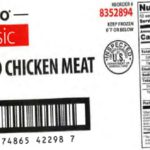May is Allergy Awareness Month and a great time to learn more about food allergies and how to keep those with allergies safe. For 2 percent of adults, and 4 to 8 percent of children in the United States, food allergies are a continuous concern. For these individuals, the immune response their body produces to normally safe items — in this case food — can lead to serious illness and even death. About 90 percent of allergic food reactions are caused by eight foods: milk, eggs, fish, crustacean shellfish, tree nuts, peanuts, wheat, and soybeans.
The only way to prevent these reactions is by completely avoiding foods that contain allergens you are allergic to; however, this can be challenging because we as Americans eat many foods that are comprised of multiple ingredients, and we often eat foods prepared outside our homes by other individuals. Reading and understanding labels along with effectively communicating food allergy risks can be paramount in protecting those with food allergies.
Reading Ingredient Statements on Labels
All food products containing two or more ingredients are required by federal regulations to have an ingredients statement listing all ingredients by common or usual name in descending order of predominance.
Reading ingredient statements on labels is the best way to avoid foods that may contain allergens. For example, some processed meat and poultry products (e.g., hot dogs, chicken nuggets and canned soup) may be formulated with known allergenic ingredients, such as nonfat dry milk or hydrolyzed wheat protein. If USDA’s Food Safety and Inspection Service (FSIS) discovers an allergen in a meat or poultry product that is not listed in the ingredient statement, the product is recalled.
For more information on recalls, or to receive email notifications when recalls or public health alerts are issued, go to www.fsis.usda.gov/Fsis_Recalls/index.asp. You can also receive automatic notifications when food safety recalls are announced by the USDA and FDA through the FoodKeeper app.
What should you do if you believe a food product contains an allergen that is not listed in the ingredients statement? First, if someone with a known food allergy begins experiencing symptoms during or after eating a food, they should initiate treatment immediately and go to a nearby emergency room if symptoms progress. The prompt administration of epinephrine by an autoinjector (EpiPen) during the early symptoms of anaphylaxis (allergic reaction) may help prevent serious consequences.
For help with meat, poultry and egg products that may have undeclared allergens, call the toll-free USDA Meat and Poultry Hotline at 1-888-MPHotline (1-888-674-6854). For help with non-meat food products (cereals, fish, produce, fruit juice, pastas, cheeses, etc.), call or write to the U.S. Food and Drug Administration. The FDA’s Center for Food Safety and Applied Nutrition can be reached at 1-888-723-3366.










